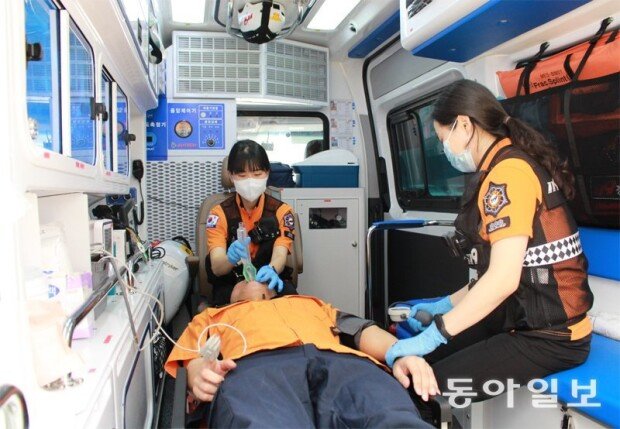96% of ambulances are too small
96% of ambulances are too small
Posted July. 31, 2023 08:13,
Updated July. 31, 2023 08:13



At a sports complex in Gyeonggi Province in April this year, a man in his 40s who suffered significant trauma is waiting for a helicopter to be transferred to a nearby regional trauma center. Before the helicopter arrived, the patient fell into cardiac arrest. The first aid workers had to get him out of the ambulance before they could perform CPR because the ambulance was too small. Multiple first aiders had to work simultaneously by pressing the patient’s chest, ensuring free airways, and putting pressure to stop the bleeding. However, it was impossible to carry out all of them in a small domestic ambulance, which is based on a 12-seat van. Ambulance workers had to perform CPR in a precarious situation outside the ambulance with the helicopter blowing wind at over 20 meters per second.
According to the National Fire Agency on Sunday, 1,737 out of 1,811 ambulances in South Korea are small vehicles that utilize 12-seat vans, such as Starex or Staria. The length of such small ambulances ranges from 5.15 meters to 5.25 meters, which is relatively short. With a patient lying on a stretcher in the car, there’s no space left above his or her head. Therefore, the ambulance worker doesn’t have good visibility into the patient’s throat while putting a tube into it to secure free airways.
The seats installed next to the patient are filled up just with two first aiders and one family member or friend of a patient, leaving just enough room for a first aid kit bag. A team of ambulance workers consists of one driver and two first aiders. For a severe case, such as cardiac arrest, two teams – at least five people – get in a single ambulance. Having four first aiders, minus the driver, in a small ambulance that drives fast often makes them bump into each other and increases the risk of injury.
The National Fire Agency introduced mid-sized ambulances using a 15-seat van model called Solati since the outbreak of COVID-19 in 2020. The length of the new ambulance is 6.19 meters, which is approximately one meter longer than its smaller equivalent and therefore allows some room for a first aid worker to sit above the patient’s head. However, there are only 74 larger ambulances, or 4.1 percent of the total. This is in contrast with other advanced countries, including the U.S. and Japan, where 14 to 15-seat vans are commonly used as ambulances.
doorwater@donga.com
Headline News
- Joint investigation headquarters asks Yoon to appear at the investigation office
- KDIC colonel: Cable ties and hoods to control NEC staff were prepared
- Results of real estate development diverged by accessibility to Gangnam
- New budget proposal reflecting Trump’s demand rejected
- Son Heung-min scores winning corner kick







